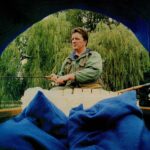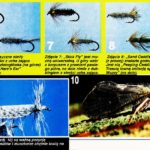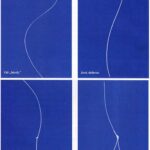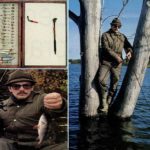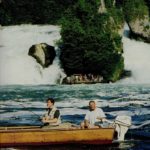Kotwiczenie łodzi wędkarskiej sprawia niekiedy wiele problemów szczurom lądowym. Podczas łowienia ryb dobrze trzymająca kotwica jest jednym z ważniejszych czynników decydujących o sukcesie.
 Kotwice mogą być bardzo różne. Porównując kotwicę składaną (na zdjęciu z lewej strony) z wykonaną we własnym zakresie i kotwicą typu „danforth” okazuje się, że ta ostatnia jest najpewniejsza.
Kotwice mogą być bardzo różne. Porównując kotwicę składaną (na zdjęciu z lewej strony) z wykonaną we własnym zakresie i kotwicą typu „danforth” okazuje się, że ta ostatnia jest najpewniejsza.
Na dobrą sprawę zakotwiczenie łodzi wydaje się być dziecinnie proste – kotwica do wody, wygodnie usiąść i już można łowić. Ach gdyby faktycznie tak było! Praktyka dowodzi bowiem, że wielu mniej doświadczonych kolegów ma poważne problemy, aby utrzymać łódź w jednym miejscu. Kotwice są bardzo różne. Mam nadzieję, że podstawowe informacje na temat „zachowania się” w wodzie poszczególnych rodzajów kotwic pozwoli Wam uniknąć wielu niepotrzebnych stresów. Największą popularnością wśród wędkarzy cieszą się tak zwane kotwice składane. Mają one w miarę ciężki korpus oraz cztery ramiona. Największą zaletą tych kotwic jest tylko to, że po złożeniu zajmują niewiele miejsca w łodzi. Największą wadą wszystkich tego typu kotwic jest to, że ich ramiona dość kiepsko wbijają się w podłoże. Przynajmniej jedno, a znacznie częściej aż dwa ramiona zawsze bezużytecznie sterczą nad dnem. Kotwice te często popuszczają, kiedy prąd wody jest trochę szybszy lub powieje silniejszy wiatr – nie dają łódce pewnego „oparcia”. Przy twardym żwirowym lub gliniastym dnie może się nawet zdarzyć, że składana kotwica w ogóle nie będzie trzymała łodzi. Wielu wędkarzy używa też samodzielnie wykonanych kotwic, przeważnie odlewanych z betonu. Takie „kamiory” są bardzo niepraktyczne, zbyt ciężkie, a przy silniejszym wietrze lub prądzie wody także niezbyt pewne, gdyż nie wchodzą w dno. Z tego względu można je polecić jedynie jako rozwiązanie awaryjne podczas łowienia w małych akwenach śródlądowych.
Lepsza kotwica
Wszystkich tych problemów unikniemy decydując się na zupełnie inną, (moim zdaniem znacznie lepszą) kotwicę. Mam tu na myśli kotwicę typu „danforth”, zwaną też płytkową. Ma ona dwie odchodzące pod pewnym kątem od korpusu płytki, które zawsze wbijają się w podłoże. Im większe naprężenie linki, tym pewniej kotwica ta wbija się w dno. Dzięki temu bardzo pewnie przytrzymuje łódkę w jednym miejscu. Po złożeniu obydwu płytek, kotwica ta nie zajmuje wiele miejsca w łodzi. Poza kotwicą istotna jest także linka. Jeżeli kotwica rzeczywiście ma pewnie trzymać łódkę, ważne jest, aby linka, przynajmniej w pobliżu kotwicy, leżała na dnie. Dlatego bardzo praktycznym rozwiązaniem jest połączenie linki z kotwicą kawałkiem ciężkiego łańcucha (przynajmniej dwa metry długości). Podobny efekt uzyskamy stosując „tonący sznur”, czyli linkę fabrycznie dociążoną ołowiem. Od czasu do czasu można ją kupić w sklepach żeglarskich. Jak z pewnością zdążyliście już zauważyć, samo opuszczenie kotwicy na dno nie zawsze wystarcza aby można było skutecznie łowić (ciągle w tym samym miejscu). Spróbujmy więc zastanowić się, co może nas czekać nad wodą. Idealne warunki to całkowity brak prądu wody i flauta. Wystarczy wtedy tylko zaznaczyć wybrane łowisko, trochę cofnąć łódkę, opuścić na dziobie kotwicę i wrócić na wybrane miejsce. Na koniec lekko naprężyć linkę i pewnie ją przywiązać. Niestety tego typu „cisza” nad wodą zdarza się niezmiernie rzadko. Znacznie częściej łódka jest narażona na działanie prądu wody, wiatru lub obydwu tych czynników naraz. Podczas aktywnego spinningowania jest to nawet dość korzystne. Opuszczamy kotwicę do wody i pozwalamy łódce tańczyć na falach i spływać z prądem, na tyle, na ile pozwala jej długość linki.
Porównanie kotwicy typu „danforth” z kotwicą składaną. Kotwica typu „danforth” połączona z linką poprzez kawałek łańcucha (przytrzymanie linki na dnie) pewnie wbija się w dno. Tym lepiej, im bardziej naprężona jest linka.
 Tylko najwyżej dwa z czterech ramion kotwicy składanej wbijają się w dno. Przy silniejszym naprężeniu linki kotwica ta lubi czasami popuszczać i łódka ciągnie ją nad dnem. Druga linka (na zdjęciu niebieska) dowiązana do końca kotwicy jest bardzo pomocna podczas podnoszenia kotwicy, szczególnie, gdy wbije się ona bardzo mocno w dno.
Tylko najwyżej dwa z czterech ramion kotwicy składanej wbijają się w dno. Przy silniejszym naprężeniu linki kotwica ta lubi czasami popuszczać i łódka ciągnie ją nad dnem. Druga linka (na zdjęciu niebieska) dowiązana do końca kotwicy jest bardzo pomocna podczas podnoszenia kotwicy, szczególnie, gdy wbije się ona bardzo mocno w dno.
Popuszczanie linki
Dzięki temu mamy możliwość spenetrowania o wiele większej powierzchni łowiska, niż przy „upalowaniu” się tylko w jednym miejscu. Jeżeli przez jakiś czas nie ma w ogóle brań, najnormalniej w świecie popuszczamy 10-15 metrów linki, czekamy aż się napręży i zaczynamy spinningować od nowa. Proszę zwrócić uwagę, że nie ma tu potrzeby wyciągania kotwicy z wody. Przy bardzo długiej lince możemy w ten sposób obłowić znaczny areał wody.
Łowienie z popuszczaniem linki jest czymś pośrednim pomiędzy łowieniem w dryfie, a łowieniem z zakotwiczonej łodzi. Metodę tę stosuje się przeważnie podczas łowienia szczupaków w dużych akwenach. Oprócz wielu zalet, popuszczanie linki kotwicznej ma jednak także pewną wadę – uniemożliwia dokładne obłowienie ściśle wybranego miejsca.
Do łowienia z gruntu węgorzy oraz ryb spokojnego żeru metoda popuszczania linki raczej nie ma zastosowania. Przy takim sposobie wędkowania łódź musi stać nieruchomo w jednym miejscu, co przy prądzie wody lub wietrze jest możliwe tylko po postawieniu dwóch kotwic.
Do skutecznego obłowienia „dziury sandaczowej” potrzebne jest bardzo dokładne zakotwiczenie się. Pierwszą czynnością, jaką musimy wykonać jest więc precyzyjne oznakowanie łowiska. Następnie płyniemy trochę pod „siłę znoszącą” łódź (prąd wody lub wiatr) i stawiamy z dziobu pierwszą kotwicę. Wypuszczamy do wody więcej linki, żeby nas zniosło trochę poniżej zaplanowanego miejsca, możemy się nawet od razu tam cofnąć. Kolejną czynnością jest postawienie drugiej kotwicy z rufy. Popuszczając linkę kotwicy rufowej i wybierając linkę kotwicy dziobowej przesuwamy się tam, gdzie chcieliśmy stać.
Po takim zakotwiczeniu się, łódka nie ma prawa ruszyć się z miejsca ani na centymetr.

